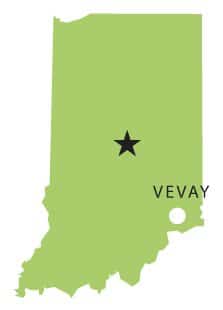
Indiana Backroads: Southern Exposure in Vevay
“Eclectic” would be the polite way to describe Vevay. “Eccentric” is more like it. How else to characterize a village whose second-best-known resident was a goat named Fred? A place where lore about said goat, dead these past two years, still flourishes—some believe he loved an apocryphal white doe—and a Fred the Goat statue (north on State Road 56, a few hundred feet from the intersection of Turnpike and Ferry streets) stands on the hillside where he freely roamed? Where the townsfolk recently held a Fred the Goat Festival and “Goats Gone Wild” art show, pieces from which ended up in the Visitors Center gallery (128 W. Main St., 800-435-5688)?
It’s Vevay’s oddball appeal, along with the picturesque Ohio River setting and impressive historic buildings, that have attracted preservationists, artists, and free-thinkers to settle among the more traditionally rural natives. The sculpture garden (215 Liberty St., 812-427-2918) of New York transplant and junk-metal artist Tony Catanzaro sits in the backyard of a Federal-style 1832 brick home occupied by one of Vevay’s most prominent settlers, Swiss emigree John Francis Dufour, who was married to a niece of Thomas Jefferson’s wife. Down the street and around the corner at A.J.’s Diner (122 W. Main St., 812-427-3540), farmers sip coffee and chew on the meatloaf special. All together, they form a community both rustic and unpretentiously sophisticated, a kind of Southern Indiana version of Northern Exposure.
While less fussed-over than nearby Madison, Vevay (that’s “vee-vee,” thank you) is also a showcase of 19th-century architectural styles, including the stately, columned Classical Revivalism of the 1864 Switzerland County Courthouse (212 W. Main St.). Most of the highlights are identified by informative, easy-to-spot markers along the walkable downtown streets, except for the circa-1805 Musee de Venoge (160 State Rd. 129, 812-593-5726) just outside of town, a modest timber-frame farmhouse and rare Indiana example of French Colonial style, often hosted by friendly period-costumed interpreters.
You can actually overnight in Vevay’s grandest historic landmark, the Second Empire–style Schenck Mansion Bed & Breakfast Inn (206 W. Turnpike St., 812-427-2787) that looms on the hillside behind iron gates. Built in 1870 by tycoon Benjamin Franklin Schenck, the “Hay King” of the Ohio, it has extravagantly spacious rooms—some with four-poster canopy beds and original copper bathtubs—a four-story tower with great views, and pillowy French toast and Parmesan-baked eggcups for breakfast.
Vevay boasts its wine heritage as much as its architecture: Its first-best-known resident, John James Dufour (brother of John Francis), established America’s earliest successful commercial vineyard in Indiana at the turn of the 18th century. You can sample current area labels at The Wine Cellar (216 Ferry St., 812-599-1358), a wine bar and shop at Vevay’s main intersection, or just outside of town at The Ridge Winery Tasting Room (11048 E. State Rd. 156, 812-427-3380), featuring an airy atrium and terraced deck with unbelievable river vistas. And as you’d expect from a wine-drinking town of colorful characters, Vevay knows how to party, with lively year-round First Friday events and, come autumn, a Bavarian Beer Bash (Oct. 2–3) and Sleepy Hollow Fall Celebration (Oct. 10) complete with a “headless” horseman.
Indy to Gosport, south on State Road 67; Gosport to Cataract, west on State Road 67, north on U.S. 231, west on N. Cataract Rd.; Gosport to McCormick’s Creek, west and south on State Road 67 to Spencer, east on State Road 46.








